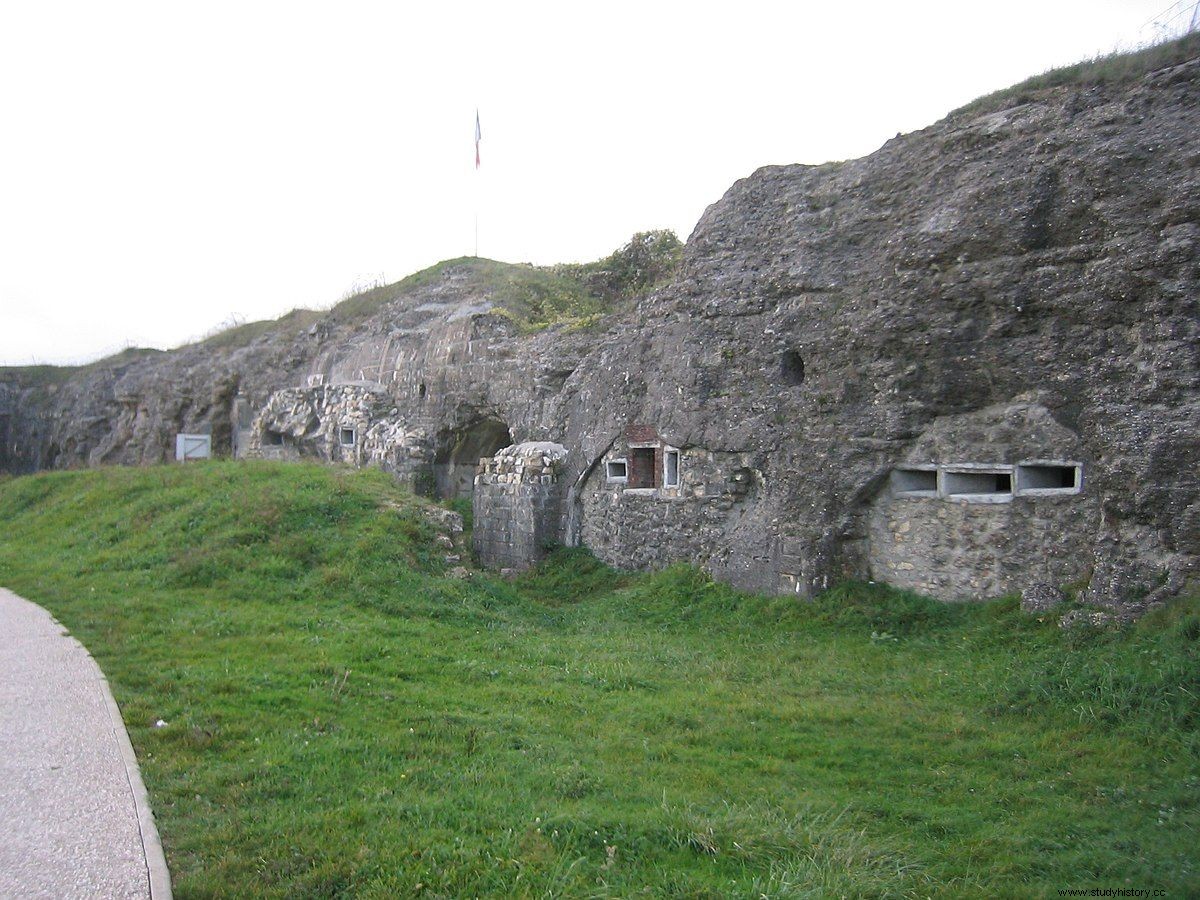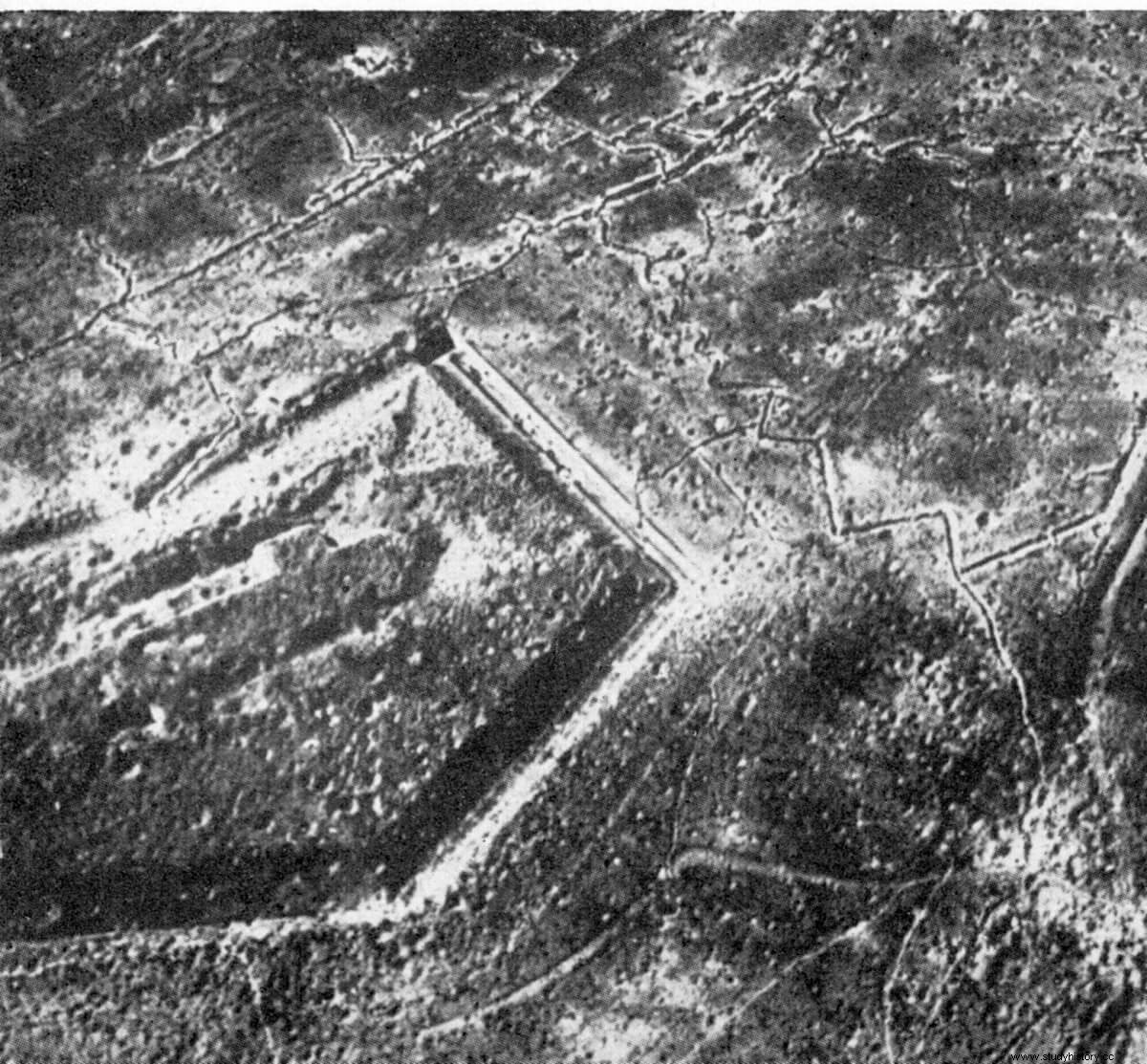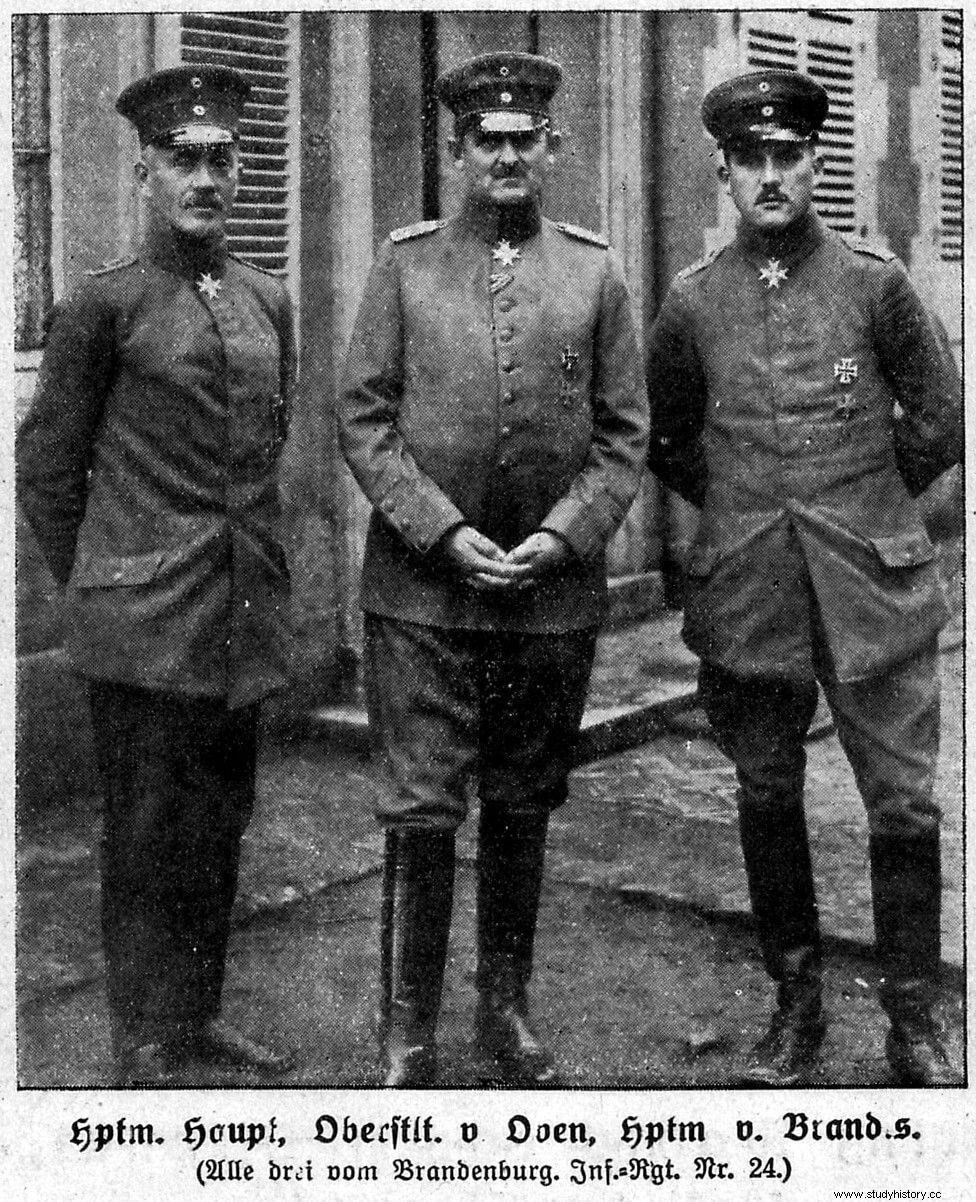
After the Franco-German War of 1870, which implied for France the loss of Alsace and Lorraine, the French general Raymond Adolphe Sére de Rivières elaborated a plan to defend the new border of the country . Said plan included four strongholds in eastern France:Verdun, Toul, Épinal and Belfort.
The city of Verdun was a strategic enclave in the defenses of the eastern border for several reasons. One of them was his position in front of the stronghold of Metz, then occupied by the Germans. The domain of Verdun also allowed control of the access roads from the east to Paris . Thus, taking these circumstances into account, a double defensive ring was built in the area consisting of 19 forts, 7 smaller fortresses, 118 artillery batteries, 23 infantry shelters and 17 other small defense structures, delimiting a perimeter around the city of about 43 kilometers [1].
Fort Douaumont, built in 1885, was the northernmost fort in the Verdun defense line . With a total area of 30,000 m2 and approximately 400 meters long, it was the largest fortress in the double defensive belt of the city. The main structure of Fort Douaumont consisted of two underground levels communicated with each other. Two main tunnels ran from east to west, one on top of the other, with corridors to the outlying areas that led to the various quarters of the barracks. A moat five meters deep surrounded the fort, whose main entrance was at the rear.
Initially Fort Douaumont was equipped with sixteen cannons of various calibers and another six pieces of flanking weaponry and had a garrison made up of 19 officers, 44 non-commissioned officers and 828 soldiers. Built in stone and brick , the appearance of new artillery shells capable of passing through these materials made the magnificent construction soon obsolete. Already in 1888 the remodeling works began of the fort. The main structure was reinforced with a 2.5 meter thick reinforced concrete frame resting on a sand cushion. All this was covered with about four meters of earth, with the aim of cushioning the impact of the larger caliber shells (380 mm, 400 mm and 420 mm). The casemates and structures auxiliary defense lines were also reinforced and covered with 1.5 meters of concrete .
Fort Douaumont, pillar of the defense of Verdun
Regarding weapons, between 1901 and 1913 the fort was equipped with a retractable swivel turret armed with a 155mm gun, a retractable swivel turret with a 75mm gun, a Bourges casemate [2] with two 75mm guns, two turrets equipped with Hotchkiss machine guns in charge of sweep the moat that surrounded the fortification and three armored observatories and two armored sentry boxes [3] as surveillance posts. Fort Douaumont thus became one of the pillars of the defense of Verdun, coming to be considered virtually impregnable .

However, at the start of the First World War , the German invasion of Belgium in 1914 forced military planners to radically rethink the usefulness of war fortifications. Belgian forts of Liege and Namur had been quickly destroyed by German artillery and easily invaded. Charlemont Fort, Ayvelles Fort, Montmédy, Maubeuge Fort, Camps-des-Romains Fort and the Antwerp defense line suffered the same fate. In view of this, on August 5, 1915, the French General Staff approved in a directive the reduction of the garrison of Fort Douaumont and other forts of the defensive ring of Verdun in order to allocate their resources, men and artillery, to other areas of the front , where it was considered that they would be most useful. Fort Douaumont was stripped in the following months of all its armament except the two turret guns of 155 mm and 75 mm, and its garrison, which numbered 477 men and 7 non-commissioned officers in 1914, was reduced to a minimum, with only 56 soldiers. middle-aged and a handful of gunners under the command of a non-commissioned officer, Brigadier Chenot.
On February 21, 1916 the German 5th Army began with an artillery preparation never seen before the offensive that would start the Battle of Verdun. At 7:15 a.m. on a cold winter dawn, 1,240 German guns grouped in a line of barely eight miles opened fire simultaneously, firing at their maximum rate of fire. The noise could be heard for a hundred kilometers around. Around 8:00 a.m. the bombardment, initially concentrated on a narrow strip of land between the Meuse River and the town of Ornes, spread in breadth and depth.
Fort Douaumont was the largest fort of the two concentric rings of fortifications that protected the city of Verdun and, therefore, cornerstone of its defense . For this reason it was a main objective for the artillery from the beginning of the offensive. In the first two days of combat alone, between February 21 and 22, Fort Douaumont received the impact of some eight hundred medium and large caliber projectiles . A battery of 420mm super-heavy M-Gerät howitzers (the fearsome Dicke Bertha Germans [4]) intermittently dropped their projectiles over 800 kilograms on the superstructure of the fort, making some of the auxiliary underground passages impracticable. The artillery attack continued unabated on February 23, 24 and 25.

Fort Douaumont falls
On the morning of February 25, after four days of uninterrupted advance, elements of the German 24th Brandenburg Regiment (6th Infantry Division, III Armeekorps ) managed to approach Fort Douaumont from the north. Most of the French garrison had taken refuge in the lower levels of the fort to escape the incessant bombardment. Observation posts were empty . Only a small team of gunners manned the 155mm turret, firing at intervals at distant German positions and enemy lines of communication, with no clear target. The fort's moat was left undefended, as there were no sharpshooters manning the Hotchkiss machine guns. About ten German sappers, led by Sergeant Felix Kunze , managed to reach said pit without encountering opposition. Immersed for days in the heat of battle, the strange stillness of the massive fortress disconcerted the assailants.
Helped by his men, Kunze managed to climb into one of the casemates that defended the moat; he found it unoccupied. A dark, narrow tunnel, the end of which could not be seen from where the sergeant stood, seemed to lead into the fort. Kunze's men, fearing an ambush, chose not to advance further, but the sergeant, armed with a carbine, decided to continue alone.
For a time Kunze wandered through the deserted tunnels from the fortress until, guided by the echo of the shots, he managed to find the artillery team manning the 155mm gun in the turret. Taking advantage of the surprise factor he captured them and locked them up.
Around noon another group from the 24th Brandenburg Regiment, led by Reserve Lieutenant Eugen Radtke , reached Fort Douaumont and penetrated the fort through its unoccupied defences. Radtke made contact with Kunze's men and organized them before they dispersed. Together they captured the rest of the defenders and secured the fort . The French garrison, made up of about 67 men in all, was taken prisoner by twenty German soldiers without having fired a single shot.
With the garrison taken prisoner and the fort under control more German troops from the 24th Brandenburg Regiment arrived , led by Captain Hans-Joachim Haupt (7th Company) and Lieutenant Cordt von Brandis (8th Company). It was these officers who definitively assumed command of the recently captured fortress.
Despite being the last officer to enter the fort, Lieutenant von Brandis was the one who sent the report on the capture of Fort Douaumont to the German High Command , a perforce brief report in which the efforts of Lieutenant Radtke and Sergeant Kunze were not mentioned. En route to Fort Douaumont, Lieutenant Von Brandis encountered a communications section that had just established a telephone connection to battalion headquarters and left the following message:“Fort Douaumont ist fest in unserer Hand. Kompanie von Brandis geht jetzt ins Fort» [5]. However, the message that actually reached the headquarters was:“Fort Douaumont ist fest in der Hand des Oberleutnants von Brandis” [6]. Von Brandis ended up becoming a national hero [7] and he was awarded the order Pour le Mérite , the highest decoration of the German Army during the Great War. Captain Haupt would also receive that award, a little later.

Kunze, the first to enter the strong and silence the 155 mm cannon taking the gunners prisoner, and Radtke, who completed the capture of the fort's garrison, received no recognition. It was not until the early 1930s, after German Great War historians reviewed the capture of Fort Douaumont , that they were compensated for their services. Radkte, who after the war was employed by the Deutsche Reichsbahn [8], received a promotion, and Kunze was belatedly awarded the order Pour le Mérite .
Fort Douaumont, the cornerstone of the system of forts that Verdun was supposed to protect of a German invasion, it had fallen without offering resistance, and its loss was a disaster for the French. The belief that Fort Douaumont could not withstand the effects of modern heavy artillery was ultimately proven wrong, and after its capture Fort Douaumont became an invulnerable refuge and operating base for German forces just behind their front line, plus an excellent observation post for their own artillery.
Before the start of the German offensive on Verdun, Fort Douaumont had lost its strategic importance for the French High Command. As of February 25, 1916, as the days, weeks, and months passed, as the battle of Verdun dragged on, recovering the fort ended up becoming a matter of honor for the French, a an obsession.
Bibliography
- Benoit G. (général) «ÉTUDE COMPARATIVE DES FORTIFICATIONS DE METZ ET DE VERDUN», Revue du Génie Militaire, Paris, Berger-Levrault, 1921, p. 8-41 and 113-137.
- Blond, Georges «THE BATTLE OF VERDUN» Unpublished Editorial. Barcelona, 2008.
- Carpentier, Jean; Lebrun, François «BRIEF HISTORY OF EUROPE» Editorial Alliance. Madrid, 1994.
- Donnell, Clayton «THE FORTIFICATIONS OF VERDUN 1874-1917» Osprey Fortress 103. Osprey Publishing Ltd., Oxford, 2010.
- Genevoix, Maurice «SOUS VERDUN» Librairie Hachette et Cie., Paris, 1916.
- Kronprinz Wilhem von Preussen «THE MEMOIRS OF THE CROWN PRINCE OF GERMANY». Thorton Butterworth Ltd., London, 1922.
- Lefebvre, Jacques-Henri «VERDUN:LA PLUS GRANDE BATAILLE DE L’HISTOIRE RACONTÉE PAR LES SURVIVANTS». Verdun Memorial Collection, 1998.
- Martin, William «VERDUN 1916:THEY SHALL NOT PASS». Osprey Campaign 93. Osprey Publishing Ltd., Oxford, 2001.
- Péricard, Jacques «CEUX DE VERDUN». Librairie Payot &Cie., Paris.,1917.
- Richthofen, Manfred Freiherrn von. «DER ROTE KAMPFFLIEGER» Verlag Ullstein &Co., Berlin, 1917.
- Rocard, Jean «LE FORT DE DOUAUMONT» Monumental Bulletin, volume 151, nº1, year 1993. pp. 311-320.
- Verdun:Preußische Groteske. Ein Legenden-Killer geht um:Er weist nach, daß die Schlacht um Verdun nicht die verlustreichste Schlacht der Historie war, als sie in die Geschichtsbücher eingegangen ist. DER SPIEGEL, 26. November 1979 (https://web.archive.org/web/20160402074032/http://www.spiegel.de/spiegel/print/d-39867416.html/)
- Erster Weltkrieg:Ein mörderisches Gemetzel. Keiner kommt durch. ZEIT ONLINE. February 2014 (http://www.zeit.de/zeit-geschichte/2014/01/erster-weltkrieg-schlacht-von-verdun-stellungskrieg/seite-2/)
- Séré de Riviéres fortification website:www.fortiffsere.fr
Notes
[1] About the fortress of Verdun, see Benoit G. (général) «ÉTUDE COMPARATIVE DES FORTIFICATIONS DE METZ ET DE VERDUN», Revue du Génie Militaire, Paris, Berger-Levrault, 1921, p. 8-41 and 113-137
[2] Casemate of Bourges :Type of auxiliary fortification designed to harass the enemy with flanking fire.
[3] About the manning and armament of Fort Douaumont , as well as the reinforcements and improvements made between 1888 and 1914 see www.fortiffsere.fr
[4] Type of 420mm siege howitzer developed by Krupp Industries during World War I. His official designation was L/12 M-Gerät 14 Kurze Marine Kanone . Its projectiles had a weight of 830 kilograms and an effective range of 12,500 meters. It was one of the largest artillery pieces fielded during the war.
[5] «Fort Douaumont it is firmly in our hands. The von Brandis Company now heads for the fort."
[6] «Fort Douaumont it is firmly in the hands of Lieutenant von Brandis.”
[7] See “Verdun:Preußische Groteske. Ein Legenden-Killer geht um:Er weist nach, daß die Schlacht um Verdun nicht die verlustreichste Schlacht der Historie war, als sie in die Geschichtsbücher eingegangen ist. DER SPIEGEL, 26. November 1979”
[8] The state railway company.
